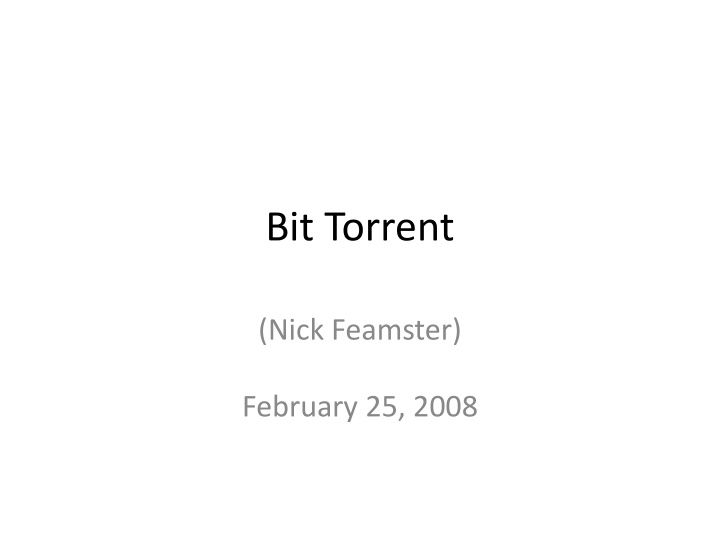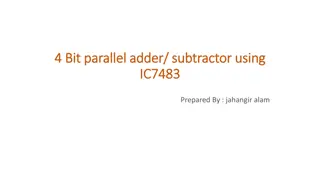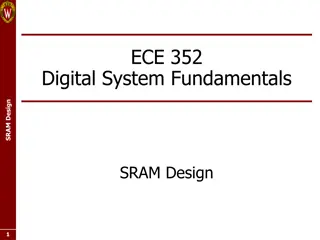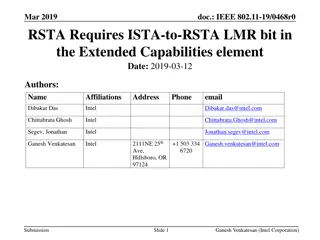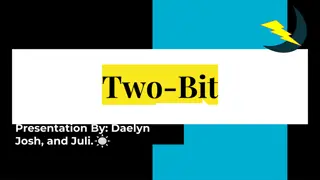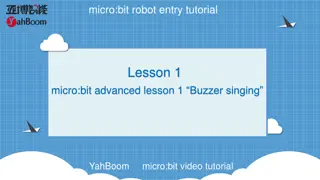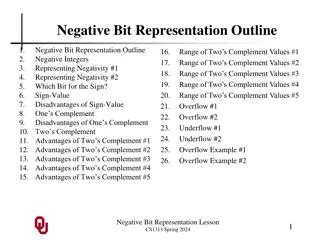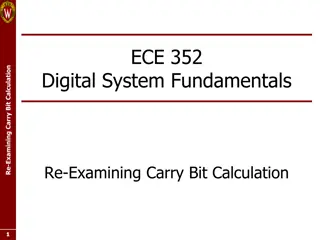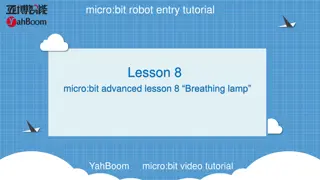Bit Torrent
BitTorrent is a decentralized peer-to-peer file sharing protocol that revolutionized how large files are distributed online. It works by breaking files into smaller pieces and distributing them across multiple users, called seeds and leechers. Utilizing game theory, BitTorrent minimizes the free-rider problem, ensuring fair sharing among peers. Components such as seeds, leechers, torrent files, and trackers play crucial roles in the process. Through tit-for-tat strategy like choking, nodes cooperate to maintain a healthy sharing environment. Learn more about how BitTorrent works and its impact on file sharing.
Download Presentation

Please find below an Image/Link to download the presentation.
The content on the website is provided AS IS for your information and personal use only. It may not be sold, licensed, or shared on other websites without obtaining consent from the author.If you encounter any issues during the download, it is possible that the publisher has removed the file from their server.
You are allowed to download the files provided on this website for personal or commercial use, subject to the condition that they are used lawfully. All files are the property of their respective owners.
The content on the website is provided AS IS for your information and personal use only. It may not be sold, licensed, or shared on other websites without obtaining consent from the author.
E N D
Presentation Transcript
Bit Torrent (Nick Feamster) February 25, 2008
BitTorrent Steps for publishing Peer creates .torrent file and uploads to a web server: contains metadata about tracker and about the pieces of the file (checksum of each piece of the file). Peers that create the initial copy of the file are called seeds Steps for downloading Peer downloads .torrent file Peer contacts tracker; tracker returns random set of peers, include seeds and leechers Peer downloads from seeds, eventually from leechers Uses basic ideas from game theory to largely eliminate the free-rider problem Previous systems could not deal with this problem 2
Basic Idea Chop file into many pieces Replicate DIFFERENT pieces on different peers as soon as possible As soon as a peer has a complete piece, it can trade it with other peers Hope to assemble the entire file at the end 3
Basic Components Seed Peer that has the entire file Typically fragmented into 256KB pieces Leecher Peer that has an incomplete copy of the file Torrent file Passive component The torrent file lists SHA1 hashes of all the pieces to allow peers to verify integrity Typically hosted on a web server Tracker Allows peers to find each other Returns a random list of peers 4
Pieces and Sub-Pieces A piece is broken into sub-pieces ... Typically 16KB; pipeline multiple requests for sub- pieces Policy: Until a piece is assembled, only download sub-pieces for that piece This policy lets complete pieces assemble quickly 5
Identifying which Peers have which Pieces Once a peer has all subpieces of a piece, it notifies the peers in its peer set by sending them a special have message for the piece. On establishing a new connection, a peer also sends a bit-field message to its new peer indicating which pieces it has.
Tit-for-Tat in BitTorrent: Choking Choking is a temporary refusal to upload; downloading occurs as normal If a node is unable to download from a peer, it does not upload to it Ensures that nodes cooperate and eliminates the free-rider problem Cooperation involves uploaded sub-pieces that you have to your peer Connection is kept open 7
Choking Algorithm Goal is to have several bidirectional connections running continuously Upload to peers who have uploaded to you recently Unutilized connections are uploaded to on a trial basis to see if better transfer rates could be found using them 8
Choking Specifics A peer always unchokes a fixed number of its peers (default of 4) Decision to choke/unchoke done based on current download rates, which is evaluated on a rolling 20-second average Evaluation on who to choke/unchoke is performed every 10 seconds This prevents wastage of resources by rapidly choking/unchoking peers Supposedly enough for TCP to ramp up transfers to their full capacity Which peer is the optimistic unchoke is rotated every 30 seconds 9
Rarest Piece First Policy: Determine the pieces that are most rare among your peers and download those first This ensures that the most common pieces are left till the end to download Rarest first also ensures that a large variety of pieces are downloaded from the seed (Question: Why is this important?) 10
Piece Selection The order in which pieces are selected by different peers is critical for good performance If a bad algorithm is used, we could end up in a situation where every peer has all the pieces that are currently available and none of the missing ones If the original seed is taken down, the file cannot be completely downloaded! 11
Random First Piece Initially, a peer has nothing to trade Important to get a complete piece ASAP Rare pieces are typically available at fewer peers, so downloading a rare piece initially is not a good idea (why?) Policy: Select a random piece of the file and download it 12
Endgame Mode When all the sub-pieces that a peer doesn t have are actively being requested, these are requested from every peer Redundant requests cancelled when piece arrives Ensures that a single peer with a slow transfer rate doesn t prevent the download from completing 13
